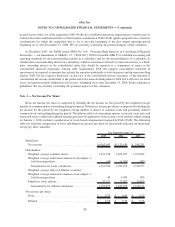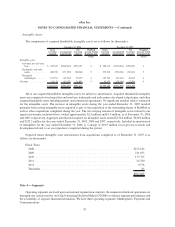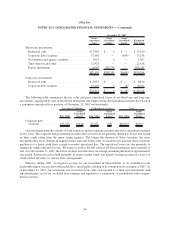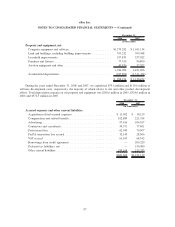eBay 2007 Annual Report Download - page 97
Download and view the complete annual report
Please find page 97 of the 2007 eBay annual report below. You can navigate through the pages in the report by either clicking on the pages listed below, or by using the keyword search tool below to find specific information within the annual report.recognize compensation expense using the accelerated amortization method under FIN 28. For stock-based awards
granted after January 1, 2006, we have recognized compensation expense based on the estimated grant date fair
value method using the Black-Scholes valuation model. For these awards, we have recognized compensation
expense using a straight-line amortization method. As FAS 123(R) requires that stock-based compensation expense
be based on awards that are ultimately expected to vest, stock-based compensation for 2006 and 2007 has been
reduced for estimated forfeitures. When estimating forfeitures, we consider voluntary termination behaviors as well
as trends of actual option forfeitures. We recognize a benefit from stock-based compensation in equity if an
incremental tax benefit is realized by following the ordering provisions of the tax law. In addition, we account for
the indirect effects of stock-based compensation on the research tax credit and the foreign tax credit through the
income statement.
Income taxes
We account for income taxes using an asset and liability approach, which requires the recognition of taxes
payable or refundable for the current year and deferred tax liabilities and assets for the future tax consequences of
events that have been recognized in our financial statements or tax returns. The measurement of current and
deferred tax assets and liabilities is based on provisions of enacted tax laws; the effects of future changes in tax laws
or rates are not anticipated. If necessary, the measurement of deferred tax assets is reduced by the amount of any tax
benefits that are not expected to be realized based on available evidence.
We account for uncertain tax positions in accordance with Financial Accounting Standards Board (“FASB”)
Interpretation No. 48, “Accounting for Uncertainty in Income Taxes” (“FIN 48”). Accordingly, we report a liability
for unrecognized tax benefits resulting from uncertain tax positions taken or expected to be taken in a tax return. We
recognize interest and penalties, if any, related to unrecognized tax benefits in income tax expense.
Recent accounting pronouncements
In September 2006, the FASB issued Statement of Financial Accounting Standards (“SFAS”) No. 157, “Fair
Value Measurements” (“FAS 157”). FAS 157 defines fair value, establishes a framework for measuring fair value
and expands disclosure of fair value measurements. FAS 157 applies under other accounting pronouncements that
require or permit fair value measurements and, accordingly, does not require any new fair value measurements.
FAS 157 is effective for fiscal years beginning after November 15, 2007. However on December 14, 2007, the FASB
issued a proposed staff position that would delay the effective date of FAS 157 for nonfinancial assets and
nonfinancial liabilities to fiscal years beginning after November 15, 2008. We do not believe that the adoption of
FAS 157 will materially impact our financial position, cash flows or results of operations.
In February 2007, the FASB issued SFAS No. 159, “The Fair Value Option for Financial Assets and Financial
Liabilities — Including an Amendment of FASB Statement No. 115” (“FAS 159”), which is effective for fiscal
years beginning after November 15, 2007. This statement permits an entity to choose to measure many financial
instruments and certain other items at fair value at specified election dates. Subsequent unrealized gains and losses
on items for which the fair value option has been elected will be reported in earnings. We do not believe that the
adoption of FAS 159 will materially impact our financial position, cash flows or results of operations.
In December 2007, the FASB issued SFAS No. 141 (Revised 2007), “Business Combinations” (“FAS 141(R)”).
FAS 141(R) establishes principles and requirements for how an acquirer in a business combination recognizes and
measures in its financial statements the identifiable assets acquired, liabilities assumed, and any noncontrolling
interests in the acquiree, as well as the goodwill acquired. Significant changes from current practice resulting from
FAS 141(R) include the expansion of the definitions of a “business” and a “business combination.” For all business
combinations (whether partial, full or step acquisitions), the acquirer will record 100% of all assets and liabilities of
the acquired business, including goodwill, generally at their fair values; contingent consideration will be recognized
at its fair value on the acquisition date and, for certain arrangements, changes in fair value will be recognized in
earnings until settlement; and acquisition-related transaction and restructuring costs will be expensed rather than
87
eBay Inc.
NOTES TO CONSOLIDATED FINANCIAL STATEMENTS — (Continued)
























